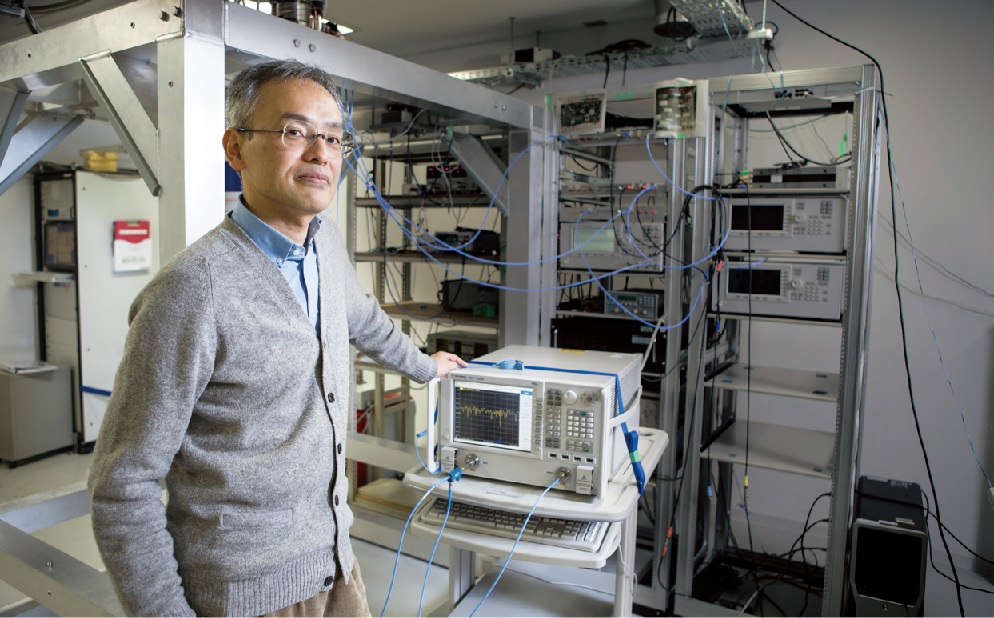- HOME
- Research at RCAST
- Visit to Laboratories
- Nakamura-Usami Laboratory
Nakamura-Usami Laboratory

One of the most mysterious characteristics of quantum mechanics is what is called the ‘superposition state.’
In the world of quantum mechanics, the state where the head of a coin coexists with the other side of the same coincan be found.
Normally this superposition state is realized only in the microscopic world and not observed in our dailylives.
I’m fascinated in controlling such mysterious characteristics of quantum mechanics properly.
I think that it must be exciting to change the views of theworld dramatically through revealing properties in the world of quantum mechanics and applying them to information technologies.
The 21st Century, the Century of Quantum Information Technologies
Prof. Nakamura is proceeding with world-leading research in order to realize a quantum computer and quantum communication devices which can make information processing and communication technology dramatically advance. Quantum mechanics is a body of theory which grew during the 20th century. Although it is not fully acknowledged, it has already contributed to every field of science and technologies surrounding us. However, there still remains a room for advancement where the mysterious nature of quantum mechanics is exploited more explicitly. “I conduct researches aiming to make the 21st century be referred to as the century of quantum technologies," said Prof. Nakamura.
He succeeded in controlling the quantum state of a superconducting circuit and generating a superposition state in 1999. It was the first demonstration in solid- state devices and his findings appeared on the cover of the science magazine, ‘Nature.' The object of his research today is to construct a ‘hybrid quantum system' in which technologies established in his research on superconductivity are combined with other quantum mechanical systems, such as photons and electrons. Each quantum system has both strong and weak points. For example, a superconducting circuit is easy to control, but photons are better for highspeed and remote communication. “I want to develop epochmaking quantum information processing and quantum communication tools by combining the strong points of each quantum," he said, explaining his idea.
Research Life in a Company
At the beginning of 1990's when Prof. Nakamura was in the master course, Japan led the world in the semiconductor industry. In those days it came to be possible to get a microscopic transistor device thanks to technical advances in making electrical circuits. Around that time, Prof. Nakamura happened to read a paper which said that new physical world would be opened when microscopic electrical devices under 1 micrometer were made. Then he got interested in the physical world of the nano region. He entered NEC Corporation after he received his master degree. At that time business corporations had better research environments than universities. “I could do whatever researches I was interested in. I put my energy into these researches," he said as he looked back on his life in the company.
He also looked back to the day when his paper had appeared in ‘Nature.' “I conducted researches driven by interest in the world of physics, for its own sake. So I was happy with the fact that I could present what I was interested in as a remarkable research. I felt that I could contribute a little to the history of quantum mechanics accumulated by my predecessors over the years, in Isaac Newton's words, ‘by standing on the shoulder of giants,' I could achieve it."
Transfer to RCAST
The Nakamura-Usami lab is a new one which started in 2012. It was a great turning point for Prof. Nakamura to leave the company for which he had worked for twenty years and come to RCAST. “I had conducted researches with superconductive circuits till then, but I became eager to try another field of research on quantum mechanics. In a research institute, it is sometimes difficult to broaden the field of research because it's not our task to continuously train students, and no one graduates from the institute as a result. Conducting researches with young people is exciting, and students give us energy and stimulus. I want to welcome, as a member of our lab, those who have the energy to achieve something new and a spirit of challenge," he said.
Each researcher in the Nakamura-Usami lab has various specialties such as superconductivity, light, spin, nano mechanics, and so on. “In order to probe one subject deeply, we should consider it in all its aspects. Otherwise, we would get stuck. Looking at subjects in other fields from other angles sometimes gives us hints on our own subject. The backgrounds of the members of our lab are so various that the ‘language' we use to discuss things is sometimes different from each other's. But I expect that such an environment with many specialists from different fields will be a stimulus to get new ideas" said Prof. Nakamura.





